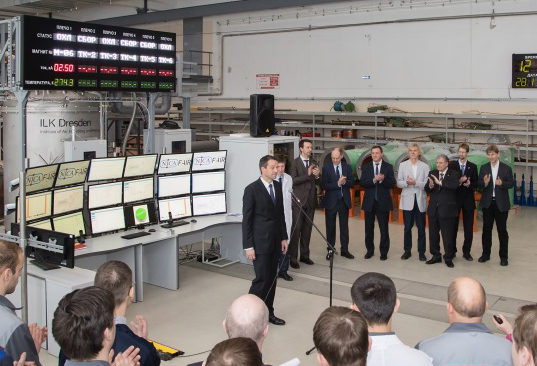Sie sehen momentan nur den öffentlichen Teil des GSI-Kuriers.
Um auch die GSI-internen Artikel angezeigt zu bekommen,
melden sie sich bitte an

Kurier - Messages from and for employees
Ausgabe: 09-2017 | 27.02. - 05.03.
News
News
Cooperation between FAIR and NICA: Test facility for superconducting accelerator magnets goes into operation in Russia
A facility for testing superconducting magnets for the two future accelerator centers FAIR (Facility for Antiproton and Ion Research) and NICA (Nuclotron-based Ion Collider fAcility) in Dubna, Russia has been put into operation with a festive ceremony. FAIR is currently being built in Darmstadt at GSI Helmholtzzentrum für Schwerionenforschung, while NICA is being constructed in Dubna at the Joint Institute for Nuclear Research (JINR). The ceremony was attended by a delegation from FAIR, consisting of project manager Dr. Jürgen Henschel and the heads of the SIS100/SIS18 sub-project, Dr. Peter Spiller and Dr. Carsten Omet. Together with the management of the NICA project, the delegation members put the new facility into operation.
JINR and GSI shared the costs of building the facility. The new facility has three connections on each side for testing magnets at extremely low temperatures. The connections on one side are for the series of booster and collider magnets for NICA and those on the other are for the series of quadrupole units for the FAIR accelerator ring SIS100. The test facility can produce helium at a temperature of 4.5 K (i.e. 4.5 degrees Celsius above absolute zero at around -273 °C) and supply it to each individual test piece. German companies made a major contribution to the facility’s construction. Among them was the firm ILK from Dresden, which manufactured the satellite cooling units.
Considerable progress was also made in technical and administrative talks held after the ceremony regarding the construction of the SIS100 quadrupole units at JINR. In particular, they fully clarified the scope of the work for production-related activities and the cryogenic tests of the first two SIS100 quadrupole units. The decisions were incorporated into a memorandum of understanding (MoU) and an addendum to the existing contract for the test facility’s construction.
This specifies that the first two (“first of series” — FOS) of the SIS100 quadrupole units will be built, cryogenically tested, and delivered to GSI for incorporation into an FOS module by mid-2017. The first of these quadrupole magnets is almost finished and it was available for inspection by the GSI delegation. The contract also covers the construction of various measuring instruments that are needed for inspecting the magnetic field and the electrical and hydraulic properties of the quadrupole units. The associated technical coordination measures are very detailed and were continued over a period of several days. The GSI department for superconducting magnet technology also visited the Russian facility, where it was represented by a five-member team of experts headed by work package manager Dr. Egbert Fischer.
Zusammenarbeit für FAIR und NICA: Testanlage für supraleitende Beschleunigermagnete geht in Russland in Betrieb

Quelle: JINR
Eine Anlage zum Testen supraleitender Magnete für die beiden künftigen Beschleunigerzentren FAIR (Facility for Antiproton and Ion Research) und NICA (Nuclotron-based Ion Collider fAcility) ist mit einer feierlichen Einweihung in Dubna, Russland, in Betrieb genommen worden. Die beiden Großprojekte FAIR und NICA entstehen derzeit in Darmstadt beim GSI Helmholtzzentrum für Schwerionenforschung und in Dubna am Joint Institute for Nuclear Research (JINR). Eine Delegation des FAIR-Projektes, bestehend aus dem Projektleiter Dr. Jürgen Henschel und der Leitung des Subprojektes SIS100/SIS18, Dr. Peter Spiller und Dr. Carsten Omet, schaltete die Anlage nun gemeinsam mit der Leitung des NICA Projektes ein.
Die Kosten für den Aufbau der Testanlage wurden zwischen JINR und GSI geteilt. Jeweils drei Anschlüsse dieser Anlage sind vorgesehen, um auf der einen Seite die Serie der Booster- und Collider-Magnete für NICA und auf der anderen Seite die Serie der Quadrupoleinheiten für den FAIR-Beschleunigerring SIS100 bei tiefsten Temperaturen zu testen. Die Testanlage kann für diesen Zweck flüssiges Helium mit einer Temperatur von 4,5 K (das entspricht 4,5 Grad Celsius über dem absoluten Nullpunkt bei rund -273 °C) erzeugen und individuell den verschiedenen Testobjekten zuführen. Zum Bau der Anlage haben auch deutsche Firmen mit wesentlichen Komponenten beigetragen, unter anderem die Firma ILK in Dresden mit der Fertigung der Satellitenkühlaggregate.
Darüber hinaus konnten im Rahmen der anschließenden technischen und administrativen Gespräche zum Bau der SIS100 Quadrupoleinheiten am JINR große Fortschritte erzielt werden. Insbesondere wurde der Umfang der Arbeiten rund um die Produktion und die Kalttests (kryogenes Testen) der ersten beiden SIS100-Quadrupoleinheiten eindeutig geklärt. Die Beschlüsse flossen in ein „Memorandum of Understanding (MoU)“ und einen Vertragsanhang zum bestehenden Vertrag für den Aufbau der Testanlage ein.
Demnach werden die ersten beiden („first of series“, FOS) der SIS100-Quadrupoleinheiten bis Mitte 2017 gefertigt, kryogen getestet und an GSI zur Integration in ein FOS-Modul ausgeliefert. Der erste der hierfür benötigen Quadrupolmagnete wurde bereits weitgehend fertiggestellt und konnte von der GSI-Delegation besichtigt werden. Bestandteil der Vereinbarung ist auch der Bau der verschiedenen Messgeräte, die zur Abnahme des Magnetfeldes, sowie der elektrischen und hydraulischen Eigenschaften der Quadrupoleinheiten benötigt werden. Die hierfür benötigten technischen Detailabstimmungen wurden über mehrere Tage fortgesetzt. Die GSI-Abteilung „supraleitende Magnettechnik“ mit dem Arbeitspaketleiter Dr. Egbert Fischer war ebenfalls mit einer fünfköpfigen Expertenmannschaft vor Ort vertreten.
Öffentlichkeitsarbeit
Die aktuellen internen Stellenausschreibungen finden Sie auch unter www.gsi.de/jobsintern
Gruppe PER-PAD










